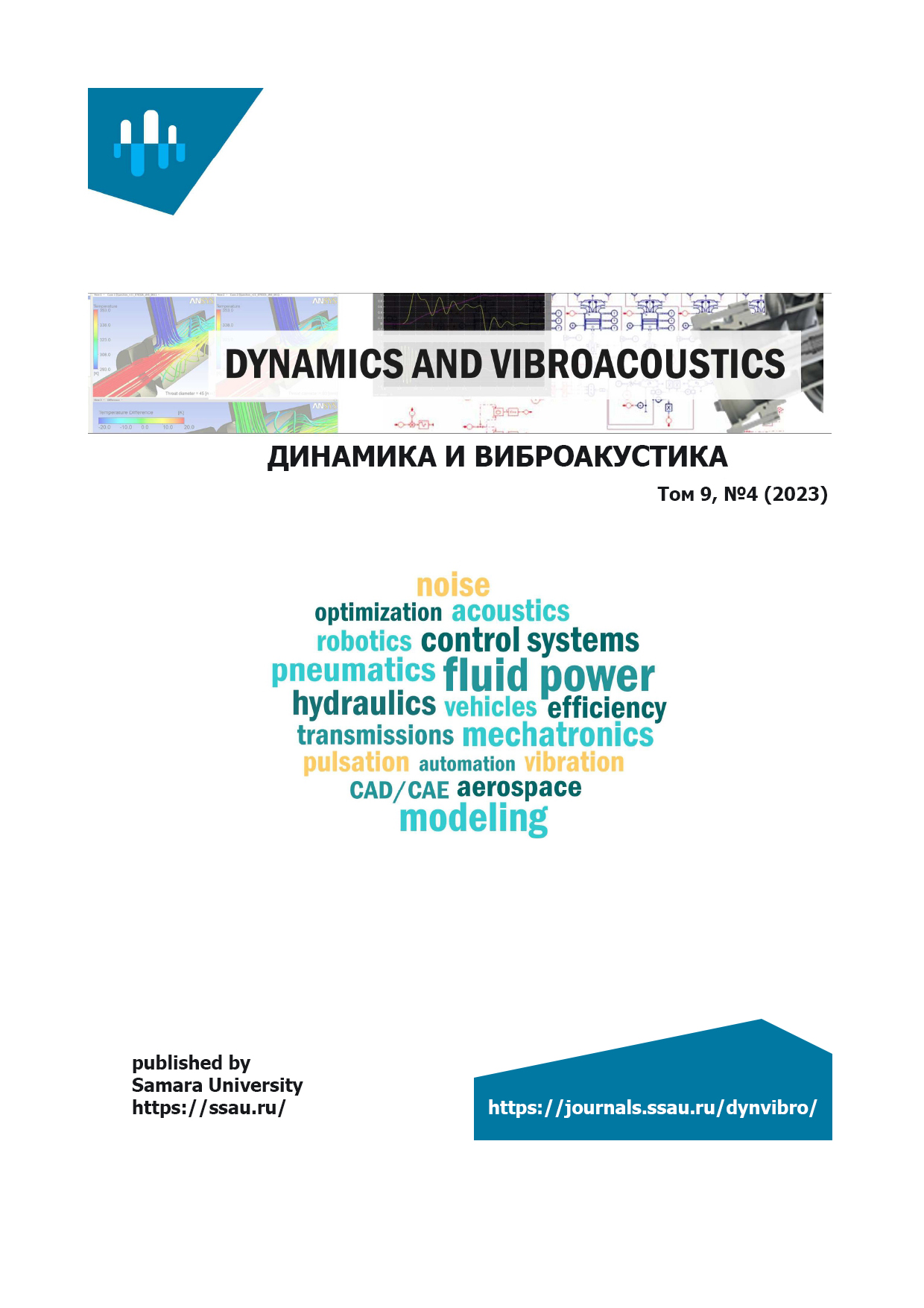RESEARCH OF THE FLOW CHARACTERISTICS OF A HYDRAULIC DRIVE BASED ON A HYDROSTATIC SUPPORT WITH MAGNETORHEOLOGICAL CONTROL
- Authors: Shelkovyy M.A.1, Bazinenkov A.M.1
-
Affiliations:
- Bauman Moscow State University
- Issue: Vol 9, No 4 (2023): 30.12.2023
- Pages: 71-79
- Section: Articles
- Published: 30.12.2023
- URL: https://dynvibro.ru/dynvibro/article/view/27083
- DOI: https://doi.org/10.18287/2409-4579-2023-9-4-71-79
- ID: 27083
Cite item
Full Text
Abstract
A hydraulic drive with magnetorheological control is an effective solution when it is necessary to ensure precise positioning of a massive object. The magnetorheological drive is capable of positioning an object weighing up to 100 kg with an error of up to 50 nm. The dynamic characteristics of the working fluid flow in various sections of the pipeline determine the technical characteristics of the device as a whole.
In this paper, the hydraulic characteristics of the drive are studied by the finite element method under laminar flow conditions. A study of the pressure at the inlet and outlet of the magnetorheological throttle showed that the pressure drop ranges from 8.2 kPa to 26.2 kPa, depending on the pressure at the inlet of the hydraulic system and the location of the throttle. The fluid flow velocity in the technological gap was 1 m/s in the center of the channel and allows us to evaluate the behavior of the drive at various operating pressures, as well as subsequently carry out a complete modeling of the system to implement the mechanism control system.
About the authors
Mikhail A. Shelkovyy
Bauman Moscow State University
Author for correspondence.
Email: shma18t387@student.bmstu.ru
2nd Baumanskaya st, 5, b 4, Moscow, 105005, Russian Federation
Aleksey M. Bazinenkov
Bauman Moscow State University
Email: shma18t387@student.bmstu.ru
2nd Baumanskaya st, 5, b 4, Moscow, 105005, Russian Federation
References
- Eshgarf, H., Nadooshan, A.A. and Raisi, A. (2022), “An overview on properties and applications of magnetorheological fluids: Dampers, batteries, valves and brakes”, Journal of Energy Storage, v. 50, p. 104648. https://doi.org/10.1016/j.est.2022.104648.
- Vishwakarma, P.N., Mishra, P.K. and Sharma, S.C. (2022), “Characterization of a magnetorheological fluid damper a review”, Materials Today: Proceedings, v. 56, pp. 2988–2994, https://doi.org/10.1016/j.matpr.2021.11.143.
- Kumar, M., Kumar, A., Kumar Bharti, R., Yadav, H.N.S. and Das, M. (2022), “A review on rheological properties of magnetorheological fluid for engineering components polishing”, Materials Today: Proceedings, 56, pp. A6–A12. https://doi.org/10.1016/j.matpr.2021.11.611.
- Li, J., Liao, C., Xie, L., Wei, X., Du, X., Gan, B. and Shou, M. (2023), “Multi-stage hysteresis modelling of magnetorheological dampers and experimental verification”, International Journal of Mechanical Sciences, v. 254, p. 108435. https://doi.org/10.1016/j.ijmecsci.2023.108435.
- Hu, G., Qi, H., Zheng, K. and Yu, L. (2022), “Design and performance evaluation of a magnetorheological valve with mosquito-coil-plate fluid flow channels”, Sensors and Actuators A: Physical, 347, p. 113983. https://doi.org/10.1016/j.sna.2022.113983.
- Huang, B.L., Zhan, W.D., Hu, W.T. and Tang, Y. F. (2020), “Force feedback based on magnetorheological fluid”, Procedia Computer Science, v. 166, pp. 15–20. https://doi.org/10.1016/j.procs.2020.02.005.
- Zhen, L., Xiaolin, W. and Zhenhua, Z. (2023), “Influence of uncertainty factors on the dynamic characteristics of magnetorheological damper”, Journal of Magnetism and Magnetic Materials, v. 585, p. 171125. https://doi.org/10.1016/j.jmmm.2023.171125.
- Deouline, E.A., Mikhailov, V.P. and Sytchev, V.V. (2000), “Control of adaptive optic element displacement with the help of a magnetic rheology drive”, Proceedings of SPIE [Preprint]. https://doi.org/10.1117/12.402755.
- Shelkovyy, M.A., Bazinenkov, A.M. and Shagimuratova, A.K. (2023), “Efficiency improvement of magnetorheological valve through geometric parameter variation of technological gap”, Journal of Dynamics and Vibroacoustics, V. 9, N. 2, pp. 25-33. doi: 10.18287/2409-4579-2023-9-2-25-33. (in Russian)
Supplementary files







